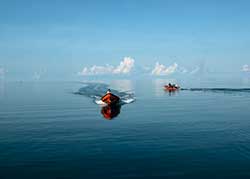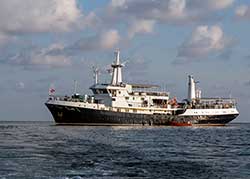
In the past I used to write lots of dive articles, but about 5 years ago I stopped writing them. Basically I got tired of writing the same old BS each time. The articles always went something like “…it was beautiful white sandy beaches, crystal clear water, the biggest fish you have ever seen, the best diving I’ve ever done… blah, blah, blah.” It was the same old stuff rehashed over and over for each destination I had visited. So I gave up on the writing as it was boring for me and most likely boring for readers.
But now, I need to write this story. I need to share with you all about what I experienced over a single weeks dive trip. I work as a marine scientist specialising in seahorses, turtles and sharks, so over the past 20 years I have done lots of diving and been fortunate enough to dive in locations all around the world, but never have I had a diving adventure as incredible as this. And the thing is, I came to this destination not knowing anything about it, not even having a clue where it was located, so when I arrived I pretty much had zero expectations. Even if I came here with high expectations, they would have been completely blown out of the water. So let me tell you about this place, the place called Tubbataha Reef.
At the end of May I bordered the MV Discovery Palawan for a 7 day liveaboard trip, the destination being Tubbataha Reef located in the Sulu Sea. The boat departs from Puerto Princessa in the Philippines and it’s a 15 hour overnight trip to the reef. The thing with Tubbataha is that it is incredibly remote, you cannot see land in any direction once you are there and diving can only be done for ONLY 3 months of the year (March-June). The rest of the time sea conditions are too rough so the reef is inaccessible. So the diving window is small. Diving can only be done by liveaboard and there are approximately only 10 boats that runs trips to the reef.
On my first dive we went to the site where they put you through a ‘check-out’ dive. Basically the dive guide wants to make sure you can breathe, float and not crash into the reef. It was here that I implemented my ‘angelfish factor’. The angelfish factor is a simple test that I implement everywhere I go diving and it’s basically how many species of angelfish can I find on a single dive. To me, angelfish are an excellent indicator of the health of a coral reef. The more angelfish species that you find, the healthier the coral reef is. My previous record for a location was 8 species of angelfish on a dive, this was from Tufi in Papua New Guinea. My very first dive in Tubbataha, I got 11 different species. We have a winner; the coral diversity and fish diversity of Tubbataha is the best that I have seen anywhere.
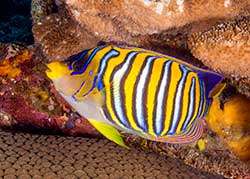
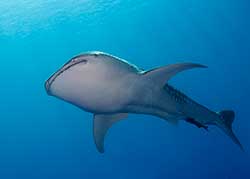
Now let’s jump to the the 2nd dive. The majority of diving in Tubbataha is wall diving, and to be honest and blunt, wall diving bores me very quickly. Categorically, I am not a wall diving fan. I’m one of the few photographers that put a macro lens on my camera when doing walls dives instead of the standard wide angle setup as I generally can’t be arsed taking photos of gorgonians fans and corals. So instead I search for nudibranchs on the coral walls, even when there is 30+ m visibility and sharks, gorgonians and soft corals in abundance.
But I digress, let’s get back to this 2nd dive. When the guide told me it was going to be a wall dive I was like ‘here we go again’ but I thought let’s keep an open mind so I put the wide angle lens on. As I descended down the wall I saw 2 grey reef sharks, then a whitetip cruised past followed by a black tip reef shark and then the whale shark swam straight up to me. WTF!!!! A whale shark just swam out of the blue and came straight at me! And not only did it swim through the 8 divers, it then turned and came back through us again. This is all happened in the first 10 minutes of the dive. And then again, towards the end of the dive, another whale shark came up to us. When we finally surfaced, all I can remember being said by the other divers is “holy shit, holy shit, holy shit”; hmmmmmmm, I think I’m going to like wall diving in Tubbataha. This single 60 min dive is one of the best dives I’ve ever done; I have never really tried to rank my best dives but this dive was so good it’s going in my top 5 dives of all time and I doubt very much I’ll be surpassing it.
The 3rd and 4th dives for the days were again wall dives, I can’t recall the name of the sites but it’s irrelevant. It’s what I saw that is relevant. On these two dives, we had a massive oceanic manta ray, a single reef manta ray, 3 dogtooth tuna buzz us that were all 4-5 foot long, dozens of napoleon wrasse, schools of barracuda, schools of bigeye jacks, schools of Bluefin trevally, spawning humphead parrotfish, hawksbill and green turtles, and then when you actually looked closely at the reef you could find lobsters, anemonefish, morays and more species of fish than you can possibly imagine. Those 4 dives on the first day just gave me the single greatest days diving in my life. I’m not joking, even with 2000 or so dives, I have never ever had a day’s diving like this. That night at dinner I was chatting with the other guests which included some very experienced divers, plus editors of two dive magazines, and everyone was in agreement it’s the best diving day they could recall.
Why is Tubbataha so incredible? Well it’s pretty simple. It’s a 97,000 hectare no take marine protected area (MPA), meaning that no forms of fishing are allowed. It became the first MPA in the Philippines in 1988 so it’s been protected for 27 years and is a listed UNESCO World Heritage Site. The effectiveness of marine protected areas (MPAs) depends on several factors such as its location and size and if you are ever interested, have a read of the Edgar et al. scientific paper published in NATURE in 2014 that describes in great detail what makes a MPA successful. One of the factors identified as being very important in ensuring MPA success is good compliance/enforcement. The more compliance there is to prevent illegal fishing, the more likely that biodiversity within the MPA will improve over time. And this is why Tubbataha is so successful.
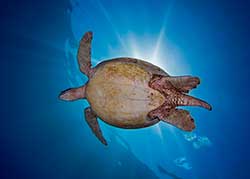
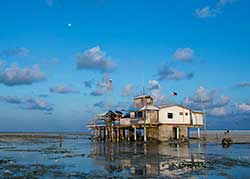
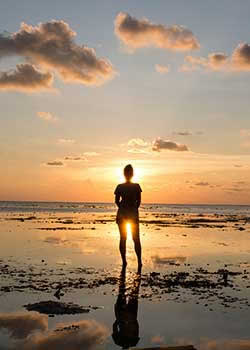
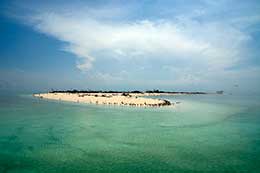
I could elaborate in great detail on about how amazing the MV Discovery liveaboard and crew was but to put it mildly I won’t as my words will not do them justice. In short, its hands down one of the best liveaboards that I have ever been on and the crew were always going out of their way to help you. And the other thing, it was a fun boat. The crew were outstanding, the happy hour cocktails each night was a blast, the last night party was hilarious and fortunately for me I was on a trip with a great bunch of people from all over the world who helped make this easily the best dive trip I have been on. Actually, kudos to the group of people that were on the boat, especially my buddies in the 'yellow team', as it was easily the best group of divers you could ever ask for to be on a liveaboard with.
I came with zero expectations and I go home now realising that Tubbataha Reef is one of the ‘ultimate’ must-do dive sites in the world. This turned out to be the trip of the lifetime and I’m stumped now as I don’t think there is going to be a destination that I could visit that could better that week I had at Tubbataha. The Galapagos Islands has always been number 1 on my bucket list and I’d always planned on going there before I cracked 40. But it doesn’t matter anymore, there is no rush for the Galapagos, as I’m now putting Tubbataha Reef on top of my bucket list as it’s the winner.
